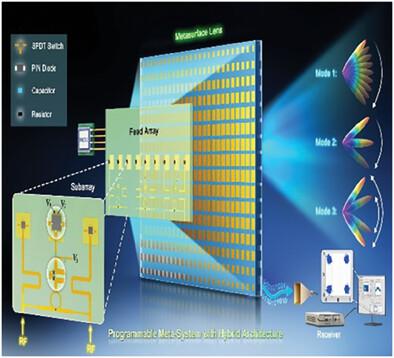当前位置:
X-MOL 学术
›
Laser Photonics Rev.
›
论文详情
Our official English website, www.x-mol.net, welcomes your feedback! (Note: you will need to create a separate account there.)
A Hybrid Architecture for Programmable Meta‐System Using a Few Active Elements
Laser & Photonics Reviews ( IF 11.0 ) Pub Date : 2024-04-09 , DOI: 10.1002/lpor.202400062 Zheng Xing Wang 1, 2 , Jun Wei Wu 1, 2, 3, 4 , Han Qing Yang 1, 2 , Qun Yan Zhou 1, 2 , Si Ran Wang 1, 2 , Hui Xu 1, 2 , Li Jie Wu 1, 2 , Yinghui Quan 5 , Qiang Cheng 1, 2 , Tie Jun Cui 1, 2, 3, 4
Laser & Photonics Reviews ( IF 11.0 ) Pub Date : 2024-04-09 , DOI: 10.1002/lpor.202400062 Zheng Xing Wang 1, 2 , Jun Wei Wu 1, 2, 3, 4 , Han Qing Yang 1, 2 , Qun Yan Zhou 1, 2 , Si Ran Wang 1, 2 , Hui Xu 1, 2 , Li Jie Wu 1, 2 , Yinghui Quan 5 , Qiang Cheng 1, 2 , Tie Jun Cui 1, 2, 3, 4
Affiliation

|
Digital coding and programmable metasurfaces stand out as promising candidates in future wireless communications due to their low costs and fast‐action reprogrammable capability. However, 2 significant obstacles, namely integration and power consumption, must be addressed before large‐scale engineering application of the programmable metasurface. This work proposes an easy‐integration and energy‐saving meta‐system and demonstrates its application in wireless communications. The meta‐system features a hybrid architecture and consists of a programmable feed array and a metasurface lens. The feed array comprises 3 subarrays, in which active elements are doped with passive elements and interconnected configurations are used to efficiently reduce the number of active elements by one‐third. The meta‐lens acts as a passive phase shifter to enhance the beamforming performance, further reducing the number of active elements. Moreover, the meta‐system can switch between different modes to achieve various functions. In particular, the maximum power consumption of the meta‐system is only 54 mW, which can be considered nearly passive. A wireless communication experiment is presented, where the meta‐system simultaneously serves as the direct digital modulator and the transmitting antenna. Owing to the low cost, high integration, and nearly passive and programmable features, the meta‐system has remarkable potential for future applications in wireless communications.
中文翻译:

使用少量活动元件的可编程元系统的混合架构
数字编码和可编程超表面因其低成本和快速可重新编程能力而成为未来无线通信中最有前途的候选者。然而,在可编程超表面大规模工程应用之前,必须解决两个重大障碍,即集成和功耗。这项工作提出了一种易于集成且节能的元系统,并展示了其在无线通信中的应用。该元系统采用混合架构,由可编程馈源阵列和超表面透镜组成。馈电阵列由3个子阵列组成,其中有源元件掺杂无源元件,并采用互连配置,有效地将有源元件数量减少三分之一。元透镜充当无源移相器,以增强波束成形性能,进一步减少有源元件的数量。此外,元系统可以在不同模式之间切换以实现各种功能。特别是,元系统的最大功耗仅为54 mW,可以认为是近乎无源的。提出了无线通信实验,其中元系统同时充当直接数字调制器和发射天线。由于成本低、集成度高、近无源和可编程等特点,元系统在未来无线通信领域的应用具有巨大的潜力。
更新日期:2024-04-09
中文翻译:

使用少量活动元件的可编程元系统的混合架构
数字编码和可编程超表面因其低成本和快速可重新编程能力而成为未来无线通信中最有前途的候选者。然而,在可编程超表面大规模工程应用之前,必须解决两个重大障碍,即集成和功耗。这项工作提出了一种易于集成且节能的元系统,并展示了其在无线通信中的应用。该元系统采用混合架构,由可编程馈源阵列和超表面透镜组成。馈电阵列由3个子阵列组成,其中有源元件掺杂无源元件,并采用互连配置,有效地将有源元件数量减少三分之一。元透镜充当无源移相器,以增强波束成形性能,进一步减少有源元件的数量。此外,元系统可以在不同模式之间切换以实现各种功能。特别是,元系统的最大功耗仅为54 mW,可以认为是近乎无源的。提出了无线通信实验,其中元系统同时充当直接数字调制器和发射天线。由于成本低、集成度高、近无源和可编程等特点,元系统在未来无线通信领域的应用具有巨大的潜力。



























 京公网安备 11010802027423号
京公网安备 11010802027423号